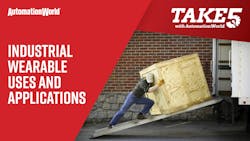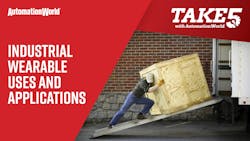
Quick hits:
- The global industrial wearable market is expected to grow from $3.79 billion in 2019 to reach $8.4 billion in 2027 for a compound annual growth rate of 12.4%.
- Wearable technology is already common in the consumer space, but has yet to see its full potential tapped in industry.
- Augmented reality headsets are commonly used to provide field service professionals hands-free access to instructions, schematics, and remote audio-video assistance from distant subject matter experts.
- Devices such as Kinetic’s “Reflex” belt-mounted sensor can be used to alert workers when they have attained a high-risk posture and improve workplace ergonomics, lowering compensation costs for repetitive strain injuries.
Related to this episode:
Automation World's feature story on how voice-controlled, hands-free wearable devices are bringing virtual and augmented reality to field service, training, and other uses.Hello. Welcome to Take Five with Automation World. I'm David Miller, senior technical writer for Automation World. In this week's episode, I'd like to talk about industrial wearables and the growing number of use cases we're seeing that involve them. Like some of the other topics we've been discussing at Automation World, AI and cybersecurity, for instance, this is one of those realms of technology we might consider a kind of next wave, something that's on the horizon that we're going to see more of going forward.
Just to give some quantitative grounding to that assertion, in terms of market expansion, the global industrial wearable market size is expected to grow from $3.79 billion in 2019 to $8.4 billion by 2027, for a compound annual growth rate of 12.4%. That data is from research in Markets.com via Business Wire. Now, when we talk about wearables, essentially all that we're referring to are IoT connected smart sensors and devices. Just like any others, except that rather than being attached to a piece of equipment or something of that nature, they're worn on the human body itself.
In the consumer market, a very simple example of this might be something like a step counter. It gathers data and provides feedback to users. And that's wearable technology. It's that simple. But one of the best ways to understand the functionality of industrial wearables is simply to go through a couple of examples of them and what they can achieve. So perhaps the most obvious examples are augmented reality headsets. These are visors with a visual readout on their interior, which can connect to a hard hat or be worn directly on a user's head.
They're connected to a network and they can display for a worker any number of instructions, schematics, or other documents all hands-free via voice activation. They can also be used to call in a remote assist from a subject matter expert who can be anywhere in the world and who can see what the user is saying and walk them through what might be a challenging technical process without being onsite. As you can imagine, this is particularly useful in the realm of field service. Where if you're up 100 feet on some kind of elevated structure trying to fix a piece of equipment, you can't exactly be using your hands to fumble with paper documents and things like that.
A more unique example of the applications wearable technologies can be put to is a product called Reflex by a company called Kinetic. This is essentially a belt mounted sensor which is to be worn by workers engaged in very physical tasks, such as lifting crates or moving heavy things, that can automatically detect when a worker is assuming what's known as a high risk posture—as in they're bending or twisting in a way that is known to result in repetitive strain injuries. From there, the device can notify the worker via a gentle vibration that they've assumed that posture, which can then help them to be more aware and to adjust their behavior accordingly. But on top of that, what it does is send data to higher-level systems where management can actually use the information to redesign the ergonomics of workspaces based on the information they receive about where these repetitive strange injuries are most likely to happen.
I think the mutual benefits of this are pretty clear. Obviously for workers, they're essentially participating in the process of making their work environment more ergonomic, which is going to in turn improve their safety and health. And then, of course, on the part of the company that is adopting these technologies, they're going to be reducing worker compensation costs that are going to be related to these injuries and other impairments that might occur on the job. There's real benefit for both parties.
Frankly, there are many other examples of industrial wearables to be deployed in the field. But for today, that's all the time we have. However, if you enjoyed the segment, keep your eyes on the space for more to come in the days ahead.

Leaders relevant to this content:



